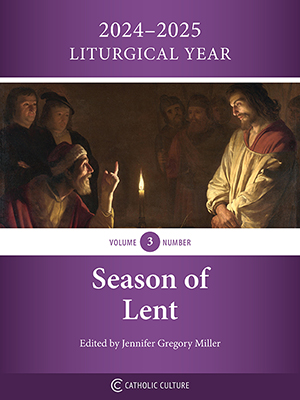Vatican II on the Church: Mary
By Dr. Jeff Mirus ( bio - articles - email ) | Mar 15, 2010 | In On the Documents of Vatican II
The final chapter of the Dogmatic Constitution on the Church is devoted to “The Blessed Virgin Mary, Mother of God in the Mystery of Christ and the Church”. This is the only chapter divided into sub-sections. It had been originally planned that the Council would issue a separate document on Mary, but by a small majority the Council Fathers decided instead to add a chapter on Mary to the Council’s central and foundational document, Lumen Gentium. This chapter deliberately unites the separate perspectives which led some fathers to emphasize Mary’s relationship with Christ and others to emphasize her relationship with the Church.
The section are entitled as follows:
- Introduction
- The Role of the Blessed Mother in the Economy of Salvation
- On the Blessed Virgin and the Church
- The Cult of the Blessed Virgin in the Church
- Mary the Sign of Created Hope and Solace to the Wandering People of God
In the Introduction, the Council explains that Mary is endowed with the “high office and dignity of being the Mother of the Son of God” yet at the same time, as one of the offspring of Adam, she is also “one with all those who are to be saved.” Thus she is “the mother of the members of Christ…having cooperated by charity that faithful might be born in the Church” and “she is hailed as a preeminent and singular member of the Church, and as its type and excellent exemplar in faith and charity.” Indeed, the Church “honors her with filial affection and piety as a most beloved mother” (53). Here the Council effectively identifies Mary as the mother of the Church, but that precise title was not actually formally conferred until Pope Paul VI did so in his final allocution closing the Council.
The second section, covering the role of Mary in the economy salvation, is a beautiful and inspiring exposition of Mary’s unique role in the history of our salvation, beginning with the earliest passages of the Old Testament concerning “the figure of the woman” (55) and ending with Mary’s exaltation as “Queen of the universe, that she might be the more fully conformed to her Son, the Lord of lords and the conqueror of sin and death” (59).
It is in the third section, on Mary’s relationship with the Church, that the Council most fully presents the synthesis of Mary’s relationships to both Christ and the Church. This process begins by emphasizing the unique mediation of Christ:
…the maternal duty of Mary toward men in no wise obscures or diminishes [the] unique mediation of Christ, but rather shows His power. For all the salvific influence of the Blessed Virgin originates, not from some inner necessity, but from the divine pleasure. It flows forth from the superabundance of the merits of Christ, rests on His mediation, depends entirely on it and draws all its power from it. In no way does it impede, but rather does it foster the immediate union of the faithful with Christ. (60)
In outlining Mary’s role the Council repeatedly acknowledges Christ’s pre-eminence. “By her obedience, faith and burning charity in the work of the Savior in giving back supernatural life to souls” Mary his become “our mother in the order of grace” (61). Nor did she lay aside this salvific duty after Christ’s work was completed and she herself was assumed into heaven, “but by her constant intercession continued to bring us the gifts of eternal salvation”, sustaining “this maternity in the order of grace”, which will last “until the eternal fulfillment of all the elect.” Hence “the Blessed Virgin is invoked by the Church under the titles of Advocate, Auxiliatrix, Adjutrix, and Mediatrix.” But this honor given to Mary must be “so understood that it neither takes away from nor adds anything to the dignity and efficaciousness of Christ the one Mediator”:
For no creature could be counted as equal with the Incarnate Word and Redeemer. Just as the priesthood of Christ is shared in various ways both by the ministers and by the faithful, and as the one goodness of God is really communicated in different ways to His creatures, so also the unique mediation of the Redeemer does not exclude but rather gives rise to manifold cooperation which is but a sharing in this one source. (62)
In this context, just as Mary is preeminently “united with her Son”, she is also “intimately united with the Church.” She is “a type of the Church in the order of faith, charity and perfect union with Christ” (63). In addition, the Church in “contemplating her hidden sanctity, imitating her charity and faithfully fulfilling the Father’s will, by receiving the word of God in faith, becomes herself a mother” (64). But while in Mary “the Church has already reached that perfection whereby she is without spot or wrinkle,” the followers of Christ “still strive to increase in holiness by conquering sin.” Therefore, “they turn their eyes to Mary who shines forth to the whole community of the elect as the model of virtues” (65).
In the fourth section, the Council turns to the cult of the Blessed Virgin and, in contrast to so much of what was done in the Council’s name during the first generation following its conclusion, the Council deliberately “admonishes all the sons of the Church” that:
the cult, especially the liturgical cult, of the Blessed Virgin be generously fostered, and the practices and exercises of piety, recommended by the magisterium of the Church toward her in the course of centuries be made of great moment, and those decrees which have been given in the early days regarding the cult of images of Christ, the Blessed Virgin and the saints, be religiously observed. (67).
The Council also issues appropriate warnings: “Let the faithful remember moreover that true devotion consists neither in sterile or transitory affection, nor in a certain vain credulity, but proceeds from true faith, by which we are led to know the excellence of the Mother of God, and we are moved to a filial love toward our mother and to the imitation of her virtues” (67).
The chapter on Mary concludes with a very brief final section on Mary as a sign of hope and solace.There follows immediately the final paragraph of Lumen Gentium, which leaves no doubt as to the document’s authority. It is Pope Paul VI’s statement of promulgation:
Each and all these items which are set forth in this dogmatic Constitution have met with the approval of the Council Fathers. And We by the apostolic power given Us by Christ together with the Venerable Fathers in the Holy Spirit, approve, decree and establish it and command that what has thus been decided in the Council be promulgated for the glory of God. (68)
Previous in series: Vatican II on the Church: Eschatological Identity
Next in series: Vatican II on Eastern Catholics
All comments are moderated. To lighten our editing burden, only current donors are allowed to Sound Off. If you are a current donor, log in to see the comment form; otherwise please support our work, and Sound Off!








